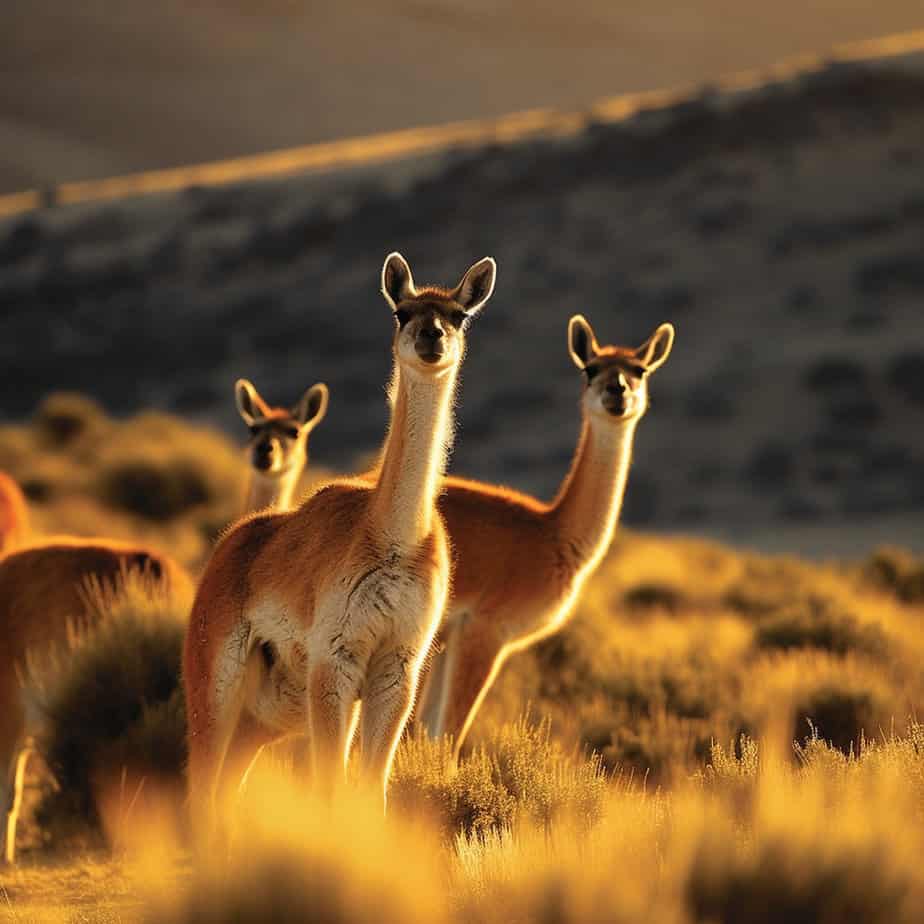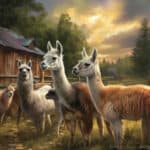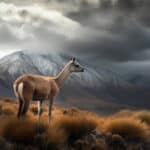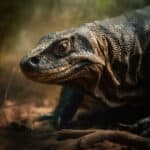Guanacos, the graceful and majestic camelids, are native to the South American continent. These fascinating creatures can be found in a variety of habitats, ranging from the arid plains of the Andes Mountains to the grasslands and shrublands of Patagonia. With their ability to adapt to different environments, guanacos have managed to thrive in regions with extreme weather conditions, such as high altitudes and low temperatures. Let’s delve deeper into the specific locations where guanacos call home and explore the unique characteristics of these remarkable animals.
Key Takeaways
- Guanacos are native to South America and can be found in various countries including Argentina, Chile, Peru, and Bolivia.
- They are well adapted to live in harsh environments such as deserts, grasslands, and mountainous regions.
- Guanacos are social animals that live in herds and have a hierarchical social structure.
- They play an important role in the ecosystem by grazing on grasses and shrubs, helping to maintain the balance of vegetation.
- Conservation efforts are necessary to protect guanacos and their habitats from threats such as habitat loss and poaching.
Understanding Guanacos: An Overview

A. What is a Guanaco?
Guanacos are fascinating creatures that belong to the camelid family, which also includes llamas, alpacas, and camels. They are native to the South American continent and are specifically found in the Andes Mountains and the Patagonian steppe. The scientific name for the guanaco is Lama guanicoe.
These majestic animals have adapted to survive in the harsh environments of the high-altitude regions of Chile and Argentina. They have a slender body, long neck, and large, expressive eyes. Guanacos are known for their graceful movements and their ability to navigate the rugged terrain of their habitat.
B. The Life Expectancy of Guanacos
Guanacos have a relatively long lifespan compared to other wild animals. On average, they can live for about 20 years in the wild. However, in captivity, where they are protected from predators and have access to regular food and medical care, guanacos can live up to 25 years or more.
The guanaco population is distributed across different regions of Chile and Argentina, with varying environmental conditions. They have adapted to survive in diverse habitats, including grasslands, shrublands, and even forests. Their ability to thrive in different environments is a testament to their resilience and adaptability.
Guanacos are herbivores, feeding primarily on grasses, shrubs, and lichens. They have a unique digestive system that allows them to extract nutrients from the vegetation in their environment. This adaptation enables them to survive in areas where food resources may be scarce.
In the wild, guanacos face several predators, including pumas, foxes, and birds of prey. These predators play a crucial role in maintaining the balance of the ecosystem by controlling the guanaco population. Guanacos have developed various defense mechanisms, such as their exceptional speed and agility, to evade predators and ensure their survival.
Conservation efforts are essential to protect the guanaco population and their habitat. Guanacos are considered a near-threatened species due to habitat loss, hunting, and competition with domestic livestock. Several organizations and governments are working together to implement conservation measures and raise awareness about the importance of preserving these magnificent creatures.
In conclusion, guanacos are remarkable animals that have adapted to thrive in the challenging environments of the Andes Mountains and the Patagonian steppe. Their ability to survive in diverse habitats, their unique adaptations, and their interactions with predators make them a fascinating species to study and protect. By understanding and appreciating these incredible creatures, we can contribute to their conservation and ensure their survival for future generations to admire.
The Natural Habitat of Guanacos

Guanacos, scientifically known as Lama guanicoe, are fascinating camelid species native to South America. These graceful creatures have adapted to thrive in a variety of environments, but they are most commonly found in the Andes Mountains and the Patagonian steppe. Let’s explore the typical environment for guanacos and what they live in.
A. The Typical Environment for Guanacos
Guanacos are well-suited to the rugged terrain and harsh climate of the Andes Mountains. Their natural habitat spans across several countries, including Chile, Argentina, Bolivia, and Peru. These majestic animals can be found at elevations ranging from sea level to over 4,000 meters (13,000 feet).
In the Andes, guanacos inhabit a diverse range of landscapes, from grassy plains to rocky slopes and mountainous regions. They are highly adaptable and can survive in areas with limited vegetation, where other animals struggle to thrive. This resilience is due to their unique adaptations and behaviors.
B. What Do Guanacos Live In?
Guanacos primarily live in herds, which provide them with safety and social interaction. These herds can consist of anywhere from a few individuals to over a hundred guanacos. Living in groups helps protect them from predators and allows for better foraging opportunities.
The guanaco‘s diet mainly consists of grasses, shrubs, and other vegetation found in their habitat. They are well-adapted to grazing on tough, fibrous plants, which enables them to survive in areas with limited food resources. Their long necks and legs allow them to reach vegetation at different heights, ensuring a varied diet.
To withstand the extreme temperatures and unpredictable weather conditions of the Andes, guanacos have developed a thick, woolly coat. This coat provides insulation during cold winters and protection from the intense sun at high altitudes. Their fur comes in various shades of brown, which helps them blend into their surroundings and avoid detection by predators.
Speaking of predators, guanacos face threats from several carnivorous species, including pumas, foxes, and wild dogs. However, their keen senses and agility help them evade these predators. Guanacos are known for their exceptional eyesight and hearing, allowing them to detect danger from a distance and react swiftly.
In terms of conservation, guanacos are considered a species of least concern by the International Union for Conservation of Nature (IUCN). However, certain populations, particularly those in more populated areas, face habitat loss due to human activities. Efforts are being made to protect their natural habitat and ensure the survival of these magnificent creatures.
In conclusion, guanacos have found their niche in the diverse landscapes of the Andes Mountains and the Patagonian steppe. Their ability to adapt to challenging environments, form social herds, and utilize their unique physical characteristics has allowed them to thrive in these regions. By understanding and appreciating the natural habitat of guanacos, we can contribute to their conservation and ensure their continued presence in the South American wildlife.
The Geographic Distribution of Guanacos

A. Where Do Guanacos Predominantly Live?
Guanacos, scientifically known as Lama guanicoe, are fascinating camelid species that inhabit the diverse landscapes of South America. These graceful creatures have adapted to survive in a range of environments, but they predominantly live in the rugged terrains of the Andes Mountains and the vast expanses of the Patagonian steppe.
Guanaco Distribution in Chile
In Chile, guanacos can be found throughout the country, from the northern regions down to the southernmost tip. They are particularly abundant in the central and southern parts of Chile, where the rugged Andes Mountains provide them with the ideal habitat. The guanacos in Chile have adapted to the harsh mountainous environment, where they navigate steep slopes and rocky terrain with ease.
Guanaco Distribution in Argentina
Just across the border in Argentina, guanacos also thrive in various regions. They are commonly found in the western provinces of Argentina, such as Mendoza, San Juan, and Neuquén. These areas offer a mix of mountainous landscapes and open grasslands, which are perfect for the guanacos’ grazing habits. The guanacos in Argentina have become an iconic symbol of the Patagonian region, captivating visitors with their majestic presence.
B. The Range of Guanaco Habitats
Guanacos have adapted to a wide range of habitats, allowing them to survive in different ecosystems across South America. Their ability to thrive in diverse environments is a testament to their resilience and evolutionary success.
Guanaco Environment
Guanacos are well-suited to the challenging environments they inhabit. They have thick, woolly coats that provide insulation against the cold temperatures of the high altitudes and the harsh Patagonian winds. Their long legs and padded feet enable them to traverse rocky terrains and navigate through snow-covered landscapes. These adaptations allow guanacos to withstand the extreme weather conditions of their habitats.
Guanaco Range
The guanaco‘s range extends from the arid regions of northern Chile and Argentina to the subpolar forests of southern Patagonia. They can be found at altitudes ranging from sea level to over 4,000 meters (13,000 feet) in the Andes Mountains. The guanaco‘s ability to inhabit such a wide range of elevations is a testament to their adaptability and versatility as a species.
Guanaco Lifestyle and Adaptations
Guanacos are social animals that live in herds, typically consisting of females, their offspring, and a dominant male. These herds provide protection against predators and allow for cooperative behaviors, such as communal defense and resource sharing. Guanacos are herbivores, primarily feeding on grasses, shrubs, and lichens. Their efficient digestive system enables them to extract nutrients from the sparse vegetation found in their habitats.
Guanaco Predators and Conservation
Despite their adaptations and social structures, guanacos face threats from natural predators such as pumas and foxes. Additionally, human activities, including habitat destruction and hunting, have impacted guanaco populations in some areas. Efforts are being made to conserve and protect these magnificent creatures, as they play a crucial role in maintaining the balance of their ecosystems.
In conclusion, guanacos predominantly live in the Andes Mountains and the Patagonian steppe, spanning across Chile and Argentina. Their ability to adapt to a variety of habitats and their unique adaptations make them a remarkable species. By understanding their distribution and the challenges they face, we can work towards ensuring the survival and well-being of these beautiful creatures.
Guanacos vs. Other Animals: A Comparative Study
A. Guanacos and Muntjacs: Where Do They Live?
When it comes to the habitats of guanacos and muntjacs, there are some striking differences. Guanacos, scientifically known as Lama guanicoe, are native to South America, specifically the Andes Mountains and the Patagonian steppe. On the other hand, muntjacs, also known as barking deer, are found in various parts of Asia, including India, China, and Southeast Asia.
Guanacos are well adapted to the harsh conditions of the Andes Mountains and the Patagonian steppe. These camelid species have developed unique characteristics that allow them to thrive in their environment. They have a thick, warm coat that helps them withstand the cold temperatures and strong winds of the high-altitude regions they inhabit. Additionally, guanacos have strong legs and hooves, which enable them to traverse the rugged terrain of the mountains and steppe.
In contrast, muntjacs prefer a different type of habitat. They are typically found in forests, woodlands, and grasslands. These small deer-like animals are well adapted to their surroundings, with their compact size and agile movements allowing them to navigate through dense vegetation. Muntjacs are known for their ability to hide and camouflage themselves, making them elusive and difficult to spot in their natural habitat.
B. Guanacos and Moreporks: A Study in Habitat Differences
Guanacos and moreporks, also known as ruru or New Zealand owls, inhabit vastly different environments. Guanacos are native to South America, while moreporks are endemic to New Zealand. Let’s explore the contrasting habitats of these two fascinating creatures.
Guanacos thrive in the open grasslands and shrublands of the Andes Mountains and the Patagonian steppe. They are well adapted to the arid conditions of these regions, where water sources can be scarce. Guanacos have evolved to survive on sparse vegetation, such as grasses and shrubs, which are abundant in their habitat. They are also known to migrate in search of food and water, allowing them to sustain themselves in challenging environments.
On the other hand, moreporks are nocturnal birds that prefer forested areas. They can be found in a variety of forest types, including native forests, plantations, and even urban parks. Moreporks rely on the cover provided by trees for roosting during the day and hunting at night. They have excellent hearing and vision, which helps them locate their prey, such as insects, small mammals, and birds, in the darkness of the forest.
C. Guanacos and Moos: Comparing Habitats
Guanacos and moose, despite their physical differences, share some similarities in their habitats. Guanacos are native to South America, while moose are found in the northern regions of North America, Europe, and Asia. Let’s delve into the habitats of these two magnificent creatures.
Guanacos inhabit the high-altitude regions of the Andes Mountains and the Patagonian steppe. They are well adapted to the cold, harsh conditions of these areas. Guanacos can be found in various habitats within their range, including grasslands, shrublands, and even rocky slopes. They are highly adaptable and can survive in environments with limited resources, such as water and vegetation.
Moose, on the other hand, prefer forested areas, particularly those with a mix of coniferous and deciduous trees. They are often found in boreal forests, taiga, and wetland habitats. Moose are excellent swimmers and are known to inhabit areas near lakes, rivers, and marshes. These large herbivores feed on aquatic plants, shrubs, and the leaves and twigs of trees, making their habitat selection crucial for their survival.
In conclusion, guanacos, muntjacs, moreporks, and moose have distinct habitats that suit their specific needs and adaptations. Understanding the environments in which these animals thrive is essential for their conservation and protection. By studying their habitats, we can gain valuable insights into the intricate relationships between these animals and their surroundings, ultimately contributing to their long-term survival.
The Impact of Environment on Guanacos
A. How the Habitat Influences Guanaco Lifestyle
The habitat in which guanacos live plays a crucial role in shaping their lifestyle and behavior. These fascinating creatures are native to the South American continent, specifically the Andes Mountains and the Patagonian steppe. Let’s explore how their environment influences their day-to-day lives.
Guanaco Distribution and Range
Guanacos, scientifically known as Lama guanicoe, are a species of camelid that can be found in various regions of South America. They are particularly abundant in Chile and Argentina, where their populations thrive in the diverse landscapes. From the high altitudes of the Andes Mountains to the vast plains of the Patagonian steppe, guanacos have adapted to survive in different environments.
Guanaco Adaptations
Guanacos have evolved several adaptations that allow them to thrive in their unique habitats. One of their notable adaptations is their ability to withstand extreme weather conditions. The Andes Mountains can experience harsh winters with freezing temperatures and strong winds, while the Patagonian steppe is known for its strong gusts and unpredictable weather patterns. To cope with these challenges, guanacos have developed a thick, woolly coat that provides insulation and protects them from the elements.
Guanaco Behavior
The environment also influences the behavior of guanacos. In the mountainous regions, where food can be scarce, guanacos have developed a grazing strategy that allows them to efficiently utilize available resources. They are selective feeders, choosing the most nutritious plants and grasses to sustain themselves. Additionally, guanacos are highly social animals and often form herds to enhance their chances of survival. Living in groups provides protection against predators and allows for better foraging opportunities.
B. The Role of Environment in Guanaco Longevity
The environment not only affects the day-to-day lifestyle of guanacos but also plays a significant role in their longevity and overall survival as a species.
Guanaco Diet
The availability of food sources in their habitat directly impacts the guanaco‘s diet. In the Andes Mountains, guanacos primarily feed on grasses, moss, and lichens, while in the Patagonian steppe, they consume a variety of shrubs and low-lying vegetation. The abundance and quality of these food sources can vary depending on factors such as rainfall and temperature. During times of scarcity, guanacos may need to travel long distances in search of food, which can be physically demanding and increase their vulnerability to predators.
Guanaco Predators
The environment also influences the presence and behavior of guanaco predators. In their natural habitats, guanacos face threats from predators such as pumas, foxes, and wild dogs. The open landscapes of the Patagonian steppe provide less cover, making guanacos more susceptible to predation. In contrast, the rugged terrain of the Andes Mountains offers more hiding places and escape routes, allowing guanacos to evade predators more effectively.
Guanaco Conservation
Understanding the impact of the environment on guanacos is crucial for their conservation. As human activities continue to encroach upon their habitats, it is essential to protect and preserve these environments to ensure the long-term survival of guanaco populations. Conservation efforts should focus on maintaining the delicate balance between human development and the preservation of natural habitats, allowing guanacos to continue thriving in their unique ecosystems.
In conclusion, the environment plays a significant role in shaping the lifestyle, behavior, and survival of guanacos. From their distribution and adaptations to their diet and interactions with predators, guanacos have evolved to thrive in diverse environments. By understanding and respecting the impact of the environment on these remarkable creatures, we can contribute to their conservation and ensure their continued existence for future generations to appreciate.
The Future of Guanacos: Conservation and Threats
A. Current Threats to Guanaco Habitats
Guanacos, the majestic camelid species native to South America, primarily inhabit the Andes Mountains and the Patagonian steppe. However, their distribution is not limited to these regions alone. The guanaco environment is diverse, ranging from high-altitude grasslands to coastal areas. Despite their adaptability, guanacos face several threats to their habitats, which could impact their survival in the future.
One of the major threats to guanaco populations is habitat loss. As human populations expand and agricultural activities intensify, the natural habitats of guanacos are being encroached upon. This loss of habitat restricts the available range for guanacos to roam freely and find suitable food sources. Additionally, habitat fragmentation caused by roads, fences, and other human infrastructure further isolates guanaco populations, making it difficult for them to migrate and maintain genetic diversity.
Another significant threat to guanacos is competition with livestock. In areas where guanacos share their habitat with domesticated animals such as sheep and cattle, there is often competition for resources such as grazing land and water. This competition can lead to overgrazing, which depletes the vegetation available for guanacos and can result in malnutrition and population decline.
Furthermore, illegal hunting and poaching pose a serious threat to guanaco populations. Despite legal protections in many countries, guanacos are still hunted for their meat, fur, and other body parts. This illegal trade not only reduces guanaco populations but also disrupts their social structure and behavior patterns.
B. Conservation Efforts for Guanaco Habitats
Recognizing the importance of conserving guanaco populations and their habitats, various conservation efforts have been implemented in countries like Chile and Argentina, where guanacos are found in significant numbers.
One approach to conservation is the establishment of protected areas. National parks and reserves provide a safe haven for guanacos, ensuring the preservation of their habitats and minimizing human interference. These protected areas also serve as research sites, allowing scientists to study guanaco behavior, population dynamics, and ecological interactions.
In addition to protected areas, community-based conservation initiatives have been successful in promoting guanaco conservation. These initiatives involve local communities in the management and protection of guanaco habitats, fostering a sense of ownership and responsibility. By involving the local population, these initiatives not only contribute to the preservation of guanacos but also promote sustainable development and economic opportunities for the communities.
Furthermore, educational programs and awareness campaigns play a crucial role in guanaco conservation. By raising awareness about the importance of guanacos and their habitats, these initiatives encourage responsible tourism, discourage illegal hunting, and promote sustainable practices among visitors and locals alike.
Overall, the future of guanacos depends on our collective efforts to address the threats they face and protect their habitats. Through conservation measures such as habitat preservation, community involvement, and education, we can ensure the survival and well-being of these remarkable creatures for generations to come. Conclusion
In conclusion, guanacos are fascinating animals that inhabit the vast and diverse landscapes of South America. They are well-adapted to survive in harsh environments, such as the high altitudes of the Andes Mountains and the arid regions of Patagonia. These graceful creatures can be found in countries like Argentina, Chile, Peru, Bolivia, and even parts of Ecuador. With their unique physical characteristics and ability to thrive in challenging conditions, guanacos have become an integral part of the ecosystems they call home. It is crucial that we continue to protect and preserve their habitats to ensure the survival of these remarkable animals for future generations to appreciate and admire.
Frequently Asked Questions
Q1: Where does the guanaco live?
The guanaco (Lama guanicoe), a camelid species, primarily lives in the South American regions of the Andes Mountains and the Patagonian steppe. They are particularly prevalent in countries like Chile and Argentina.
Q2: What habitat do guanacos live in?
Guanacos inhabit a variety of environments, from the cold mountainous regions of the Andes to the arid grasslands of the Patagonian steppe. They have adapted to these diverse conditions, demonstrating a remarkable range of guanaco adaptations.
Q3: How long do guanacos live?
On average, wild guanacos live for about 20 to 25 years. Their lifespan can be influenced by factors such as diet, predators, and environmental conditions.
Q4: What does a guanaco live in?
Guanacos do not build homes or nests, but roam freely across their range, which includes the Andes Mountains and Patagonian steppe. They are well adapted to these environments, with a lifestyle that involves grazing on grasses and shrubs.
Q5: Where do moreporks live?
Moreporks, also known as ruru or southern boobook, are native to New Zealand. They can be found in various habitats, including forests, farmlands, and even urban parks.
Q6: Where does the muntjac live?
The muntjac, a type of small deer, is native to South Asia and can be found in countries like India, Sri Lanka, and Indonesia. Some species have also been introduced to Europe.
Q7: What are the main predators of the guanaco?
The main predators of the guanaco include pumas and humans. Young guanacos, known as chulengos, may also fall prey to foxes and birds of prey.
Q8: How is guanaco conservation being addressed?
Efforts to conserve the guanaco population include habitat protection, hunting regulation, and research to better understand their behavior and needs. These efforts are crucial to ensure the survival of this unique South American wildlife species.
Q9: What is the current status of the guanaco population?
While guanaco populations have declined due to hunting and habitat loss, they are not currently considered endangered. However, they are listed as a species of least concern by the International Union for Conservation of Nature (IUCN).
Q10: What is the diet of a guanaco?
Guanacos are herbivores, primarily grazing on grasses and shrubs found in their South American habitats. Their diet helps them survive in the harsh conditions of the Andes Mountains and the Patagonian steppe.




